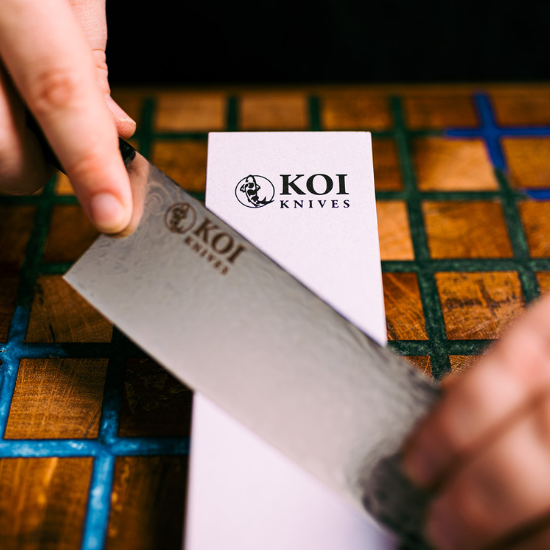If you enjoy cooking or working as a chef, you know the tremendous effect a sharp blade can have on your dishes. This article will examine how to free your prized Japanese blades from dullness grip. We can appreciate how frustrating it can be when a blade struggles to glide as it once did.
We'll look at whetstone honing, a time-tested technique that will refresh your knife's edge and improve your cooking skills.
Understanding Japanese Knife Blades
Japanese kitchen knives are more than just kitchen tools; they are an extension of the chef's creativity. Japanese knives are highly regarded for their accuracy, finesse, and exceptional sharpness.
A Japanese knife has a complex design at its core. The blade is built differently, with each component serving a specific function. These knives are a symphony of form and function, from the sturdy double-bevelled edge of the Gyuto to the single-bevelled precision of a Yanagiba.
Many Japanese knives are made of high-carbon steel, which requires regular maintenance. It's crucial to comprehend the subtle differences between various blade types, the craft of tempering, and the relevance of HRC hardness ratings.
The Art of Whetstone Sharpening
If the cutting edge of your blade has dulled over time, there is no need to worry. By utilising a well-selected whetstone and employing the proper technique, you can restore the sharpness of your kitchen tool, rejuvenating its functionality.
Exploring the World of Whetstones
Imagine whetstones as the architects of sharpness, each with its own personality – coarse, medium, fine – designed to suit different sharpening stages. Selecting the right one depends on your blade's initial condition and your desired level of refinement.
Selecting the Right Grit for Your Dull Knife
Grit matters, and here's the secret handshake: lower grit for repairing chips and major dullness, higher grit for honing and polishing. It's like starting with a rough canvas and ending with a masterpiece.
Preparing the Whetstone and Knife for Sharpening
Before the dance begins, soak your whetstone in water for about 10 to 15 minutes. Place it on a stable surface with a damp cloth underneath to prevent slipping. Secure your knife with a non-slip mat or a wet paper towel – safety first, maestro.
Establishing the Sharpening Angle
Visualise a magic number - around 15 to 20 degrees for most Japanese knives. It's the angle between the blade and the whetstone, a sweet spot for optimal edge restoration. Practice this angle with steady hands; you're about to sculpt precision.
Executing the Sharpening Strokes
With a Zen-like focus, engage the stone with controlled sweeps. The primary bevel sharpening shapes the edge, while the secondary bevel refinement polishes it to sheer elegance. Repeat, refine, restore – you're guiding your blade's rebirth.
Step-by-Step Whetstone Sharpening Technique
Now that you understand the significance of maintaining the edge of your Japanese knife, it's time to delve into the art of whetstone sharpening. This method, deeply rooted in traditional Japanese craftsmanship, can revive even the dullest blades with patience and precision.
- Assess the Blade's Condition: Lay your knife on a flat surface and examine the edge. Identify any nicks, chips, or inconsistencies that need special attention.
- Establish the Sharpening Angle: This angle varies based on the blade's bevel. For most Japanese knives, a 15-20-degree angle works well. Some knives might have a double bevel, requiring a more precise approach.
- Primary Bevel Sharpening: Start with a coarse-grit whetstone. Wet the stone and place it on a non-slip surface. Hold the knife at the chosen angle and gently slide it across the stone in controlled strokes. Alternate sides, maintaining an even pressure. Repeat until you form a burr on one side.
- Secondary Bevel Refinement: Switch to a finer-grit stone. Repeat the process, focusing on removing the burr while maintaining the angle. Alternate sides until you achieve a clean, sharp edge.
- Honing and Polishing: Finish with a fine grit or polishing stone. Hone the edge with light strokes to remove any remaining burr and refine the sharpness.
- Testing the Edge: Carefully run your finger along the edge to feel for any inconsistencies. A well-sharpened blade will feel smooth and even.
Remember, each knife has its personality, so take your time and experiment. And always, always prioritise safety—use a non-slip surface, maintain a steady hand, and keep fingers well away from the blade's path.
Honing and Polishing for Razor-Sharp Results
Honing and polishing are the final steps in your journey toward culinary precision. Just as a musician tunes an instrument before a performance, honing aligns your knife's edge, ensuring optimal cutting performance.
- Importance of Honing
Think of honing as a gentle nudge to your blade's alignment. Frequent use can cause the microscopic edge to shift slightly. Honing realigns this edge, keeping your knife at its prime. Remember, honing is preventive, not corrective.
- Techniques for Honing and Polishing
- Begin with a well-lubricated whetstone, setting your knife at the recommended angle.
- Using controlled motions, alternate the sides of your blade for an even edge.
- Gradually progress to finer grit stones to refine the edge, akin to a fine sanding finish.
- Final Polishing
Here's where your blade truly shines. A high-grit whetstone or leather strop puts the finishing touches. This step refines the edge to a mirror-like gleam, enhancing the knife's cutting prowess.
Your restored Japanese knife, now razor-sharp, eagerly awaits its role in crafting delectable creations.
Caring for Your Newly Sharpened Japanese Knife
Proper Cleaning and Drying
After the sharpening session, gently wipe down your knife with a damp cloth to remove any residual grit or particles. Be meticulous around the blade and handle junction. Promptly dry the knife to prevent water spots and potential rust formation. A moisture-free environment is your blade's best friend.
Storage Considerations
Your newly sharpened Japanese knife deserves a cosy spot. Consider investing in a knife block, magnetic strip, or blade guard to protect the edge from accidental bumps and nicks. A dedicated space showcases your knife's sharpness and keeps it readily accessible.
Regular Maintenance Practices
Maintaining that sharp edge isn't a one-time affair. Develop a routine that includes regular honing using a honing rod. Lightly honing before each use helps maintain the sharpness and prolongs the time between major sharpening sessions.
Your Japanese knife is a work of craftsmanship and precision. Treat it with respect and a little TLC, and it will reward you with exceptional performance and effortless culinary experiences.
Conclusion
As we come to a close, remember that your ability to prepare food is only as good as what you have on hand. You are preserving the history of these knives and improving your craft by becoming an expert in this field.
With each stroke across the whetstone, you create precision and flavour, imbuing each dish with authenticity. So, enjoy the rhythm of sharpening, the gentle dialogue between the blade and the stone, and the symphony of tastes your newly revived Japanese knives will create.




